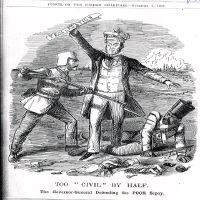
Too "Civil" by Half 7 November 1857

 n this cartoon, Sir John Tenniel, portrays the vengeance of British sentiment against the sepoys who participated in the Indian Mutiny. The cartoon is critical of Governor-General Canning and his support of the Clemency Resolution which restricted the powers of British military officers to punish suspected rebels without a trial or appeal. At the time that he passed this resolution, almost all the English stationed in India and a great majority of the British people at home in England disapproved of his action.
Tenniel's depiction of the poor Sepoy in this cartoon clearly demonstrates the sharp change in British feeling towards the sepoys after the Mutiny. The Indian soldier is darker and more savage-looking than most of the depictions of Indians before the Mutiny. He is barefoot and has oversized hands and feet which would signal to a Victorian reader familiar with the racial anthropology of the age a connection with the apes and other animals. Tenniel shows him as a murderous brute who has slaughtered innocent British children and still has their blood on his sword. He is baring his teeth as if reveling in his bloodthirsty killing spree.
n this cartoon, Sir John Tenniel, portrays the vengeance of British sentiment against the sepoys who participated in the Indian Mutiny. The cartoon is critical of Governor-General Canning and his support of the Clemency Resolution which restricted the powers of British military officers to punish suspected rebels without a trial or appeal. At the time that he passed this resolution, almost all the English stationed in India and a great majority of the British people at home in England disapproved of his action.
Tenniel's depiction of the poor Sepoy in this cartoon clearly demonstrates the sharp change in British feeling towards the sepoys after the Mutiny. The Indian soldier is darker and more savage-looking than most of the depictions of Indians before the Mutiny. He is barefoot and has oversized hands and feet which would signal to a Victorian reader familiar with the racial anthropology of the age a connection with the apes and other animals. Tenniel shows him as a murderous brute who has slaughtered innocent British children and still has their blood on his sword. He is baring his teeth as if reveling in his bloodthirsty killing spree.
The British children are blond-haired and almost doll-like in their purity. They had been innocently playing with toys when they were cruelly killed by the sepoy. In a similar manner, Tenniel depicts the British officer as a noble, upright, fair-skinned man who is avenging the children's murders. His body proportions (such as his small nose, hands, and feet) are less animalistic, and therefore more evolved, than the sepoy's. He seems baffled that anyone would try to prevent him from killing the sepoy, who obviously (to an outraged British public) deserves it.
This cartoon shows the Indian sepoy as belonging to a race separate from the British. The British officer has a facial angle of almost 90 degrees whereas the sepoy's chin juts out, proving that he is a member of one of the savage races. This cartoon illustrates the idea that the British must rule India, a nation of savages, with an iron first because even the supposedly loyal sepoys will reveal their true animalistic and savage nature if given the opportunity.
[Victorian initial "I" by Harlan Wallach ©copyright 1994.]